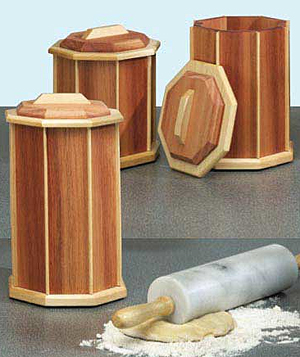
I just finished building a project (the “Classic Canister Set”) and ran into a finishing problem. I built them out of cherry and walnut, so to “pop” the grain I used a light coat of boiled linseed oil, let it dry 24 hours, then applied two coats of shellac, thinned to 50 percent. After 24 hours, I sanded lightly with 400-grit wet/dry paper, wiped off the resulting dust with mineral spirits, then applied a coat of polyurethane, also thinned to 50 percent. I used a rag to apply both the shellac and poly. Everything was fine up to this point. The second coat of poly, however, didn’t dry properly. After 48 hours, it was still a bit tacky and soft even though everything was identical to the first coat — i.e., the same batch of poly/mineral spirits mixture, the same room and temperature, etc. I should add that the poly was probably a bit old, although it wasn’t skinned over in the can and it didn’t appear to have thickened. But even taking that into consideration, my process in applying both coats was identical — the first one worked, the second one didn’t. What happened? – Ken Serge
Rob Johnstone: When I hear that a finish is remaining tacky and refusing to dry, my first thought is that the finish is old and no longer viable. Can I explain why it was OK with the first coat and not with the second … nope. At this point in time, it is not really important why it stayed tacky. (I would get rid of that poly, though.) Were it my project, I would remove the tacky poly, let the piece sit for 24 hours (in a heated space, not a cold garage …), then sand it smooth and apply a new coat of a freshly purchased poly. Getting the tacky stuff off is going to be a pain. I’d try some coarse steel wool combined with flooded-on mineral spirits to see if that will get it off of the wood. If not, then I’d move to a cabinet scraper and elbow grease.
Chris Marshall: What a frustrating outcome, Ken. Sorry to hear it, but before you strip off the tacky poly, it might be worth just letting time heal this wound. In other words, give the varnish even more time to cure. In Bob Flexner’s book “Understanding Wood Finishing” (every woodworker should own a copy of this book, in my humble opinion), he suggests that cold air (below 60 degrees Fahrenheit) or oily woods can retard the curing time of varnish. But, since you used cherry instead of something like rosewood, and since your first coat of poly cured hard but not the second, all around it’s hard to say exactly what is up here. If the finish stays tacky after a week or so in a warmed environment, both you and Rob are probably right: the varnish is probably just past its prime. Maybe it now contains a higher ratio of oil than resin or too little of the metallic driers that help it cure. Whatever the case may be, make sure to stir your new can of varnish thoroughly to blend the oil, resin and driers it contains. Better luck next time!





